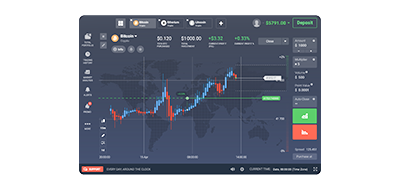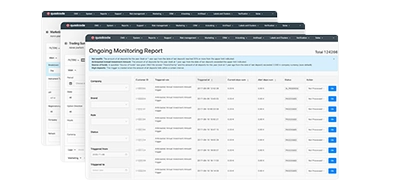กลับ
Contents
ADX Indicator คืออะไร และใช้งานอย่างไร?

Vitaly Makarenko
Chief Commercial Officer

Demetris Makrides
Senior Business Development Manager
ตัวบ่งชี้ดัชนีทิศทางเฉลี่ย (ADX) ทำหน้าที่เป็นเครื่องมือสำหรับประเมินความแข็งแกร่งของแนวโน้มตลาด โดยเน้นที่ความเข้มข้นมากกว่าทิศทาง ไม่ว่าจะเป็นแนวโน้มขาขึ้นหรือขาลง เทรดเดอร์ให้ความสำคัญกับตัวบ่งชี้ ADX เป็นอย่างมาก เนื่องจากความน่าเชื่อถือและความยืดหยุ่นในการใช้งาน ซึ่งมักนำไปใช้ในตลาดหุ้น ฟิวเจอร์ส และกองทุนรวม
การอ่านตัวบ่งชี้ ADX
ADX แสดงเป็นเส้นเดี่ยวที่ลากจากศูนย์ถึงหนึ่งร้อย ADX เป็นตัวบ่งชี้ที่ไม่ใช่ทิศทาง แสดงถึงความแข็งแกร่งของแนวโน้มไม่ว่าราคาจะขึ้นหรือลง
ดัชนีที่ประกอบด้วย 3 เส้น ได้แก่ เส้น ADX, ตัวบ่งชี้ทิศทางบวก +DI และตัวบ่งชี้ทิศทางลบ DI โดยค่าที่สูงกว่า 25 แสดงถึงแนวโน้ม ในขณะที่ค่าที่ต่ำกว่า 25 แสดงถึงแนวโน้มหรือการเคลื่อนไหวด้านข้างภายในช่วงที่เฉพาะเจาะจง
ตัวบ่งชี้ ADX สร้างเส้นที่แสดงความเข้มและแอมพลิจูดของแนวโน้มได้อย่างชัดเจน หากค่าคะแนนสูงกว่า 25 แสดงว่ามีแนวโน้มที่แข็งแกร่งอย่างมีนัยสำคัญ แนวโน้มอาจเคลื่อนไหวขึ้นหรือลง ขึ้นอยู่กับตำแหน่งสัมพัทธ์ของเส้น +DI และ -DI เมื่อค่าคะแนน ADX ลดลงต่ำกว่า 0 เทรดเดอร์ควรดำเนินการด้วยความระมัดระวัง ซึ่งมักบ่งชี้ว่าตลาดเริ่มเคลื่อนไหวในแนวโน้มที่อ่อนแอหรือเข้าสู่ช่วงกรอบราคา เทรดเดอร์ควรละเลยสัญญาณดังกล่าวและหลีกเลี่ยงกลยุทธ์การซื้อขายที่อิงตามแนวโน้มของตลาดในสถานการณ์ปัจจุบัน
ด้วยเหตุนี้ เทรดเดอร์จึงดึงสัญญาณการซื้อขายจากปฏิสัมพันธ์ระหว่างเส้น +DI และ -DI หากเส้น ADX กำลังเพิ่มขึ้นและเส้น +DI อยู่เหนือเส้น -DI เทรดเดอร์อาจสันนิษฐานว่าแนวโน้มขาขึ้นกำลังจะเริ่มต้นขึ้น ในทางกลับกัน เมื่อเทรดเดอร์เห็นเส้น -DI สูงขึ้นเหนือเส้น +DI และเส้น ADX กำลังลดลง พวกเขาจะตีความว่านี่เป็นจุดเริ่มต้นของแนวโน้มขาลง
ข้อจำกัดของ ADX
แม้ว่าอินดิเคเตอร์ ADX จะมีการใช้งานที่เป็นประโยชน์หลายประการ แต่สิ่งสำคัญคือต้องตระหนักถึงข้อจำกัดของมัน ดังที่ได้กล่าวไปแล้ว มันคืออินดิเคเตอร์ที่ล่าช้า ซึ่งหมายความว่ามันขึ้นอยู่กับข้อมูลราคาและการเคลื่อนไหวในอดีต ดังนั้นมันจึงไม่ตอบสนองต่อการเปลี่ยนแปลงของสภาวะตลาดได้อย่างทันท่วงที ปัญหานี้อาจนำไปสู่สัญญาณที่พลาดหรือการเข้าซื้อขายล่าช้า โดยเฉพาะอย่างยิ่งในตลาดที่มีความผันผวนและมีการเคลื่อนไหวอย่างรวดเร็วจำนวนมาก
และดังที่ได้กล่าวไปแล้วข้างต้น เนื่องจาก ADX ไม่ได้แสดงทิศทางตลาด แต่แสดงเพียงความแข็งแกร่งเท่านั้น จึงจำเป็นต้องใช้ร่วมกับตัวบ่งชี้อื่นๆ เพื่อหาข้อมูลเชิงลึกเกี่ยวกับทิศทางตลาดและแนวโน้ม นอกจากนี้ การพยายามแยกแยะและวิเคราะห์เส้น ADX และปฏิสัมพันธ์ระหว่างเส้น +DI และ -DI อาจเป็นเรื่องยาก การใช้ ADX นี้อย่างมีประสิทธิภาพและเข้าใจการอ่านค่าในบริบทของตลาด จำเป็นต้องอาศัยประสบการณ์และความเข้าใจตลาดเป็นอย่างดี
การใช้ตัวบ่งชี้ ADX
ตัวบ่งชี้ ADX มีประโยชน์มากมายนอกเหนือจากการช่วยเทรดเดอร์วัดความแข็งแกร่งของแนวโน้มเท่านั้น เมื่อใช้ร่วมกับตัวบ่งชี้อื่นๆ จะช่วยให้เทรดเดอร์ได้รับข้อมูลที่เป็นประโยชน์มากมาย ซึ่งอาจช่วยปรับปรุงกลยุทธ์การเข้าและออกจากการซื้อขายได้ การประยุกต์ใช้ตัวบ่งชี้ ADX เกี่ยวข้องกับรูปแบบการไดเวอร์เจนซ์
สิ่งนี้เกิดขึ้นเมื่อ ADX แสดงแนวโน้มไปในทิศทางหนึ่ง แต่ราคาของสินทรัพย์เคลื่อนไหวไปในทิศทางตรงกันข้าม ซึ่งหมายความว่าอาจมีการเปลี่ยนแปลงของความรุนแรงของแนวโน้ม หากเทรดเดอร์เห็นราคาสินทรัพย์หนึ่งกำลังเพิ่มขึ้น แต่ราคากลับลดลงพร้อมกับเส้น ADX นี่เป็นสัญญาณบ่งชี้ว่าแนวโน้มขาขึ้นกำลังจะสิ้นสุดลง ดังนั้น พวกเขาอาจพิจารณาว่าเป็นช่วงเวลาที่เหมาะสมในการทำกำไรจากการซื้อขาย
เมื่อพยายามพิจารณาว่าการทะลุแนวรับนั้นผิดพลาดหรือไม่ เทรดเดอร์มักใช้ ADX ผู้ดูแลสภาพคล่องมักใช้การทะลุแนวรับเพื่อหลอกลวง โดยเฉพาะอย่างยิ่งในตลาดที่มีความผันผวนสูง เช่น ตลาดคริปโต การเคลื่อนไหวของราคาอาจรุนแรงพอที่จะทะลุแนวรับหรือแนวต้าน จากนั้นจึงกลับตัวและกลับตัว การเปิดคำสั่งซื้อขายโดยอาศัยการทะลุแนวรับอาจส่งผลให้เกิดการขาดทุนทางการเงินจำนวนมาก อย่างไรก็ตาม ตัวบ่งชี้ ADX สามารถนำมาใช้เพื่อลดความเสี่ยงนี้ได้
ก่อนเริ่มทำธุรกรรม เทรดเดอร์อาจดูค่า ADX หากค่าที่ได้ต่ำกว่า 25 แสดงว่าการทะลุแนวรับมีแนวโน้มที่จะเป็นเส้นหลอก และตลาดขาดความแข็งแกร่งที่จำเป็นในการรักษาระดับการทะลุแนวรับไว้ ซึ่งหมายความว่ามีโอกาสเกิดการกลับตัวได้ ในทางกลับกัน หากเทรดเดอร์เห็นค่าที่สูงกว่า 25 ซึ่งบ่งชี้ถึงแนวโน้มตลาดที่แข็งแกร่ง พวกเขาอาจเข้าซื้อด้วยความมั่นใจมากขึ้น โดยคาดการณ์ว่าตลาดจะยังคงมีโมเมนตัมต่อเนื่อง
บรรทัดล่าง
ตัวบ่งชี้ ADX เป็นเครื่องมือที่มีประสิทธิภาพในการประเมินความแข็งแกร่งของแนวโน้มตลาดได้อย่างแม่นยำเมื่อใช้อย่างเหมาะสม เช่นเดียวกับเครื่องมือ ตราสาร และตัวบ่งชี้อื่นๆ ตัวบ่งชี้ ADX จะทำงานได้ดียิ่งขึ้นเมื่อใช้ร่วมกับเครื่องมืออื่นๆ ซึ่งจะทำให้ภาพรวมตลาดสมบูรณ์ยิ่งขึ้นและการตัดสินใจที่ดีขึ้น เทรดเดอร์ที่สามารถเรียนรู้ เข้าใจ และนำตัวบ่งชี้นี้ไปประยุกต์ใช้ รวมถึงจุดแข็งและจุดอ่อนของตัวบ่งชี้ จะสามารถทำการซื้อขายได้อย่างมั่นใจและแม่นยำ นำไปสู่ผลกำไรที่มากขึ้นและผลกำไรที่ดีขึ้น
อัปเดต:
19 ธันวาคม 2567




